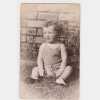| Profile | Posted by | Options | Post Date |

|
Belinda
|
Report
|
17 Nov 2008 12:50 |
|
I believe that a Captain on the Leviathan may have been a relative but can't trace where he fits in. There was a picture found amongst a relatives belongings but we can't find out why or whether there is a connection.
The picture was taken March 1925 Mid Atlantic. He was actually performing a marriage between Nora Bayer and Benjamin Friedland, he was her fifth husband, whom I believe to be Americans.
Is there anyone out there who may have any info, or can tell me where I might find something out about him.
Thank you for looking.
Belinda.
|

|
AnnCardiff
|
Report
|
17 Nov 2008 13:01 |
|
SS Leviathan, originally built as the SS Vaterland, was an ocean liner which regularly sailed the North Atlantic briefly in 1914 and from 1917 to 1934. The second of a trio of transatlantic liners built by Germany's HAPAG Line for the transatlantic passenger service, she would sail as the Vaterland for less than a year before her early career was halted by the start of World War I. In 1917, she was seized by the U.S. government and renamed the Leviathan. She would become known by this name for the majority of her career, both as a troopship during World War I and later as the flagship of the United States Lines.
Contents [hide]
1 German service
2 World War I
3 American service
4 Trivia
5 Notes
6 External links
[edit] German service
Painting of the Vaterland
The huge Vaterland prior to New York.SS Vaterland, a 54,282 gross ton passenger liner, was built by Blohm & Voss at Hamburg, Germany, as the second of a trio of very large ships of the Imperator class for the Hamburg-America Line's trans-Atlantic route. She was launched 13 April 1913 and was the largest passenger ship in the world upon its completion, superseding SS Imperator and later being superseded by the last ship of this class, SS Bismarck, the later RMS Majestic.
Vaterland had made only a few trips when, in late July 1914, she arrived at New York, NY just as World War I broke out. With a safe return to Germany rendered virtually impossible by British dominance of the seas, she was laid up at her Hoboken, NJ, terminal and remained immobile for nearly three years.
[edit] World War I
The USS Leviathan in a dazzle camouflage pattern.She was seized by the United States Shipping Board when the United States entered World War I, 6 April 1917; turned over to the custody of the U.S. Navy in June 1917; and commissioned July 1917 as the USS Vaterland [1] , Captain Joseph Wallace Oman in command. Redesignated SP-1326 and renamed Leviathan by President Woodrow Wilson on 6 September 1917. The trial cruise to Cuba on 17 November 1917, prompted Captain Oman to order 241 Marines, onboard to relieve a detachment of Devil Dogs, to station themselves conspicuously about the upper decks giving the appearance from shore that the great ship was headed overseas to increase American Expeditionary Forces.[2] Upon her return later that month, she reported for duty with the Cruiser and Transport Force. In December she took troops to Liverpool, England, but repairs delayed her return to the U.S. until mid-February 1918. A second trip to Liverpool in March was followed by more repairs. At that time she was repainted with the British-type "dazzle" camouflage scheme that she carried for the rest of the war. With the completion of that work, Leviathan began regular passages between the U.S. and Brest, France, delivering up to 14,000 persons on each trip, carrying over 119,000 fighting men, before the armistice 11 November 1918. After that date Leviathan, repainted grey overall by December 1918, reversed the flow of men as she transported the veterans back to the United States with nine westward crossings ending 8 September 1919. On 29 October 1919, USS Leviathan was decommissioned and turned over to the U.S. Shipping Board and again laid up at Hoboken until plans for her future employment could be determined.
[edit] American service
The Leviathan
The Leviathan was reincarnated as the flagship of the American merchant fleet.In April 1922 the decision was made about the role of the ship and the Leviathan steamed to Newport News, Virginia, where she was completely renovated to suit American tastes and post-World War I standards. Her reconditioning completed in June 1923, the Board turned her over to the United States Lines to operate on their behalf as the U.S. Flag ocean liner Leviathan.
As SS Leviathan, she was the "queen" of the United States' merchant fleet, and operated in the trans-Atlantic trade into the early 1930s. Dubbed "Levi Nathan", the ship was reasonably popular, but because of her American registry she had to sail as a "dry ship" under Prohibition and many American travellers preferred European liners which were permitted to serve liquor once they were in international waters. Despite this handicap, the Leviathan in 1927 was the #1 ship on the Atlantic in terms of average passengers carried per crossing. The Great Depression hit passenger shipping hard and the Leviathan, like other big liners of the time, began to lose money. She was laid up in 1933 and, with the exception of several months of additional service in 1934, was inactive until 10 December 1937, when she was sold to a British firm and made her final Atlantic crossing to Rosyth, Scotland shortly thereafter, where she was broken up on over the next two years.
|

|
AnnCardiff
|
Report
|
17 Nov 2008 13:02 |
|
do you have his forename?
|

|
Julia
|
Report
|
17 Nov 2008 13:44 |
|
Ann of GG- your ability to find out information never ceases to amaze me. That being so, can I please ask you to find out what you can about a ship called PRINZ HEINRICH, obviously German. It sailed from Southampton to Singapore in April 1908. I know it had on board a German Master, but would it have a British Captain, and how can I access the passenger and crew lists, for that voyage
Many thanks
Julia in Derbyshire
PS Belinda, don't mean to hijack your thread, but, if Ann is into this, I could do with her help
Many thanks
Julia in Derbyshire
|

|
AnnCardiff
|
Report
|
17 Nov 2008 13:46 |
|
I'm nosy!!! I just google for it - will take a look for yours
|

|
AnnCardiff
|
Report
|
17 Nov 2008 13:48 |
|
Prinz Heinrich, was a faster but lightly armoured variation of the Furst Bismarck Heavy Cruiser. The Prinz Heinrich was intended to serve in the Overseas stations. The Prinz Heinrich was intended to be the first of a total of 16 heavy cruisers for service in the German Colonies and to replace the old cruisers which were stationed there. Built at Kiel Dockyard, and laid down in 1898, launched 22nd march 1900 and competed 11th March 1902. Work was started in 1914 at Kiel for refit. but this was stopped in 1916 when she was disarmed and used as a engineers training ship and a depot ship at Kiel. she was finally sold for scrap to Audorf Rendsburg in 1920.
Displacement 9652 tons -, speed: 20.5 knots, Compliment 594. Armament: Four 210mm (9.4inch) (2x2) Ten 150mm (5.9-inch) Twelve 88mm (3.4inch) and four Machine Guns Four Torpedo Tubes 1 submerged in the bow, Two submerged in the beam and One above water line in the stern.
|

|
AnnCardiff
|
Report
|
17 Nov 2008 13:48 |
|
operation to bombard Hartlepool on 16 December, 1914. Prinz Heinrich, along with Roon, was assigned to the van of the High Seas Fleet, which was providing distant cover to Rear Admiral Hipper's battlecruisers, which were conducting the bombardment. [1]
In April 1915, she was transferred to the Baltic Sea, although less than a year later, in March 1916, she became a barracks ship, and served in that capacity until the end of the war. Prinz Heinrich was scrapped in 1920
|

|
Julia
|
Report
|
17 Nov 2008 13:48 |
|
Thanks Ann, I'm not very good with Google.Never know what to click onto when I've got there
Julia in Derbyshire
|

|
AnnCardiff
|
Report
|
17 Nov 2008 13:49 |
|
SMS Prinz Heinrich was the oldest German armoured cruiser to see service during the First World War. She had been built under the Second Navy Law, to act as an overseas station ship, and was a faster but lighter version of SMS Fürst Bismarck, the first German armoured cruiser. Because she was intended for service in tropical seas, her hull was sheathed with wood (designed to be replaced easily on a regular basis). She was the first German cruiser to carry all of her secondary armament in the central citadel that was a feature of all German battleships and heavy cruisers of the pre-dreadnought era.
In August 1914 the Prinz Heinrich was undergoing a refit. She was back with the fleet in time to take part in the raid on the Yorkshire coast of 15-16 December 1914. Prinz Heinrich, and the slightly more modern but very similar cruiser Roon acted as a screen for the battle squadrons that put to sea to support the battlecruisers undertaking the raid itself. The Prinz Heinrich remained with the fleet until 1916, when she was disarmed and used as a depot ship at Kiel. She was followed into service by the two very similar Prinz Adalbert class cruisers
|

|
AnnCardiff
|
Report
|
17 Nov 2008 13:50 |
|
SMS Prinz Heinrich
Built Kiel Navy Dockyard, laid down December 1898, completed March 1902, cost 16,588,000 Marks.
Size:
Length 410 feet 1 inch waterline 415 feet 4 inches overall, beam 64 feet 4 inches, draught 26 feet 6 inches, displacement 8,857 load 9,806 tons full load.
Propulsion:
3 shaft Triple expansion engines, 15,000 ihp, 20 knots
Trials: 15,694 shp = 19.9 knots
Armour:
4in belt, 6in turret faces, 2in decks
Armament:
2 x 9.4in 40cal (2 x 1), 10 x 5.9in 40 cal (10 x 1), 10 x 3.45in (10 x 1), 4 x 17.7in TT
Comments:
Smaller, cheaper design with reduced armour and armament but slightly higher speed. Crew 567.
World War 1 Service:
Prinz Heinrich
III Scouting Group.
16 December 1914 took part in the operation to bombard Hartlepool.
Apr 1915 onwards Baltic Sea.
March 1916 Used as barrack ship.
1920 Sold for scrapping.
SMS Prinz Heinrich. Like other German large cruisers, she was intended for overseas duties but once war had started this role was not viable and they were not modern enough to be useful in the more dangerous North Sea or Baltic theatres and were soon relegated to secondary roles
|

|
Julia
|
Report
|
17 Nov 2008 13:51 |
|
Ann, just seen your replies, many thanks, but how do I find the answers to the other parts of me question.
Julia in Derbyshire
|

|
Belinda
|
Report
|
17 Nov 2008 19:41 |
|
no I dont have a forename for CAPTAIN HARTLEY. All I know is that sometimes there were five Captains at a time on these large ships.
I really wanted to know how I could trace him.
Glad to be of use Julia, hope you found out what you wanted to know about your ship !!!
If someone could tell me how to trace hin on the ship I would be grateful. I wonder if there are any relatives of the married people about?
|

|
AnnCardiff
|
Report
|
17 Nov 2008 19:46 |
|
not a clue about the passengers and crew, but hang in there and someone will come up with someting for you - have faith!!
Ann
|

|
AnnCardiff
|
Report
|
18 Nov 2008 09:56 |
|
Belinda - where mainly does your family come from - location wise that is?
|

|
AnnCardiff
|
Report
|
18 Nov 2008 09:58 |
|
by the way Jan, if you google for Leviathan it is all there for the looking! nothing clever in it all!!
|

|
Belinda
|
Report
|
18 Nov 2008 12:08 |
|
thanks again for everyones help.
The Hartleys I know of in the family originated from yorkshire, one of which married a Louisa Cooke from Kidderminster, Worcestershire.
Thanks Colin, I will try and see if he fits in with any of the Hartleys I know of.
|

|
WayneTracey
|
Report
|
18 Nov 2008 12:13 |
|
New York Passenger Lists, 1820-1957
about Herbert Hartley
Name: Herbert Hartley
Arrival Date: 21 Dec 1923
Estimated Birth Year: abt 1880
Age: 43
Gender: Male
Port of Departure: Southampton
Ethnicity/Race/Nationality: American
Ship Name: Leviathan
Search Ship Database: View the Leviathan in the 'Passenger Ships and Images' database
Port of Arrival: New York, New York
Line: 1
Microfilm Serial: T715
Microfilm Roll: T715_3431
Page Number: 212
Listed as the Ships Master. The only Master of this ship.... I can send you the image if you wish
Tracey
|

|
WayneTracey
|
Report
|
18 Nov 2008 12:16 |
|
I was going to post some more... but it appears he's spent alot of time ping ponging from Southampton to new York....!!!
Tracey
|

|
WayneTracey
|
Report
|
18 Nov 2008 12:19 |
|
Here you go !!!
His father was English..... i'll see what i can find now!!
U.S. Passport Applications, 1795-1925
about Herbert Hartley
Name: Herbert Hartley
Birth Date: 28 May 1875
Birth Place: Oswego Falls, New York
RESIDENCE: Jersey City, NY
Passport Issue Date: 7 Nov 1916
Father Name: Ellis Hartley
Father's Birth Location: England
Passport Includes a Photo: Y
Source: Passport Applications, January 2, 1906 - March 31, 1925 (M1490
The data on the form states he's a Master Mariner!
Tracey
|

|
WayneTracey
|
Report
|
18 Nov 2008 12:27 |
|
Could this be your man?
1900 United States Federal Census
about Herbert Hartley
Name: Herbert Hartley
Home in 1900: Colwyn, Delaware, Pennsylvania
Age: 24
Birth Date: May 1876
Birthplace: England
Race: White
Ethnicity: American
Immigration Year: 1880
Relationship to head-of-house: Son
Father's Name: Ellis
Father's Birthplace: England
Mother's Name: Emily
Mother's Birthplace: England
Marital Status: Single
Residence : Colwyn & Yeason Boroughs, Delaware, Pennsylvania
Occupation: View Image
Neighbors: View others on page
Household Members: Name Age
Ellis Hartley 50
Emily Hartley 48
Clara Hartley 29
Herbert Hartley 24
I will try and find Ellis's Emmigration record.
Name: Ellis Hartley
Home in 1900: Colwyn, Delaware, Pennsylvania
Age: 50
Birth Date: Mar 1850
Birthplace: England
Race: White
Ethnicity: American
Immigration Year: 1880
Relationship to head-of-house: Head
Father's Birthplace: England
Mother's Birthplace: England
Spouse's Name: Emily
Marriage Year: 1871
Marital Status: Married
Years Married: 29
Looks like they married in the UK?
Tracey
|

